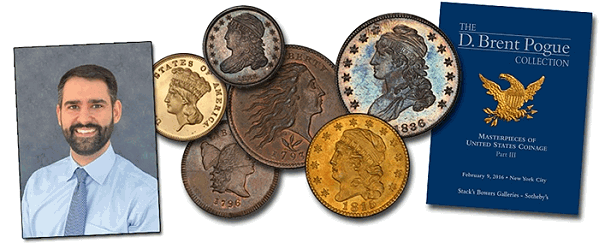
By John Kraljevich, Numismatic Consultant – Stacks Bowers …..
Coin collectors may not seem an especially reverent lot. Casual demeanor and good senses of humor are more commonplace than their opposites, from local coin shows to Manhattan auction galleries. The bourse floor is a leveler that puts experts and connoisseurs shoulder to shoulder with hobbyists of all levels. Proximity breeds familiarity, and most of today’s legendary collectors and experts are a coin-show handshake or an email away.
Our relationship to the great names of the past is more distant and less easily affirmed. We connect with the experts and collectors who have gone before us in three ways: the coins they owned or studied, the writings and photographs they left behind, and the still thriving numismatists of an earlier generation who knew them well. Their names are whispered. The books they wrote are prayerfully thumbed into disrepair or bound in rich leathers to preserve the words within. The coins they owned are cherished like talismans, their provenance extending a stamp of approval from the great beyond. Stories about their hijinks, or cabinets, or human foibles, are campfire tales wherever numismatists gather to break bread or find the bottom of a bottle.
While numismatists–in particular those who collect early United States coins–have a reverence for those who came before them, their reverence does not extend to themselves. The collectors of today tend not to be entirely self-conscious about their place in this historical continuum. The friends they visit at coin shows and afterward join for dinner are not acknowledged as VIPs whose biographies will be reconstructed by future researchers; they’re simply their friends. The prizes they find on bourse floors and in auctions are not considered future objects of research and inquiry, they are simply nice additions to their collections. And the catalogs they read may be viewed as sales tools, bound for the recycling bin, rather then works that will be studied by collectors not yet born.
Those who participate in the Pogue auctions are taking part in history. The collections and biographies of those who purchase these coins will be pondered, studied, and researched, long after all who knew them personally are gone. The coins bid upon in this sale will continue to be the focus of scholarly and collector interest, just as they were a century ago. Notes taken in the catalogs of those who view these coins or attend the sale will be scrutinized by future generations.
Out of reverence for the coins themselves, and for the place of this catalog in numismatic history, many people have assisted with the task of producing this catalog. Fellow researchers like P. Scott Rubin, Craig Sholley, John Dannreuther, Saul Teichman, Joel J. Orosz, Mike Spurlock, David Tripp, and W. David Perkins willingly and collegially shared the fruits of their labors, with no greater hope than to add to the published historical record. Others opened their libraries or probed the depths of their memories, helping to find tidbits published long ago but mostly forgotten or sharing recollections that have never before been put into print. Their respect for our predecessors in the pursuit of numismatic knowledge, for the past and present relationships that have carried these coins into the 21st century, and for the coins themselves has made this catalog a more useful reference, and I am thankful for all their assistance.
The Stacks’ Bowers Galleries staffs in Wolfeboro, New York, and Santa Ana are constantly busy with projects, but each of these have made the production of this catalog their top priority for the months that went into its creation:
John Pack and Greg Cohen, separated by 3,000 miles but united by the modern marvel of text messaging, were always within reach of a required obscure reference.
Jennifer Meers is a Swiss Army knife, a ready resource, a talented designer, and a trusted editor.
Q. David Bowers’ memories, universal knowledge, and careful editing are each specialized tools beyond compare.
Frank Van Valen’s cataloging work on the Pogue Collection of $3 gold pieces brought honor to one of the greatest collections ever formed of the denomination.
Their contributions were each invaluable.
In 1907, Henry Chapman wrote in his introduction to the Matthew A. Stickney sale: “To prepare this catalog has been a labor of love, as I am greatly interested in our pursuit and expect to devote my life to it.” I wonder if his wife, Helen, was as patient as my wife, Megan, during the long hours it took to assemble the Stickney catalog. The name Pogue is a proper noun representing a family, a connoisseur, and a world-class collection, but in our home it has become a verb, and I am grateful for the support as hours turned to days, weeks, and months spent Pogueing.
The half cents, cents, dimes, half dollars, and half eagles in this sale each tell a great story. I am proud to have been allowed to study each of them and honored to have been their mouthpiece as they come to auction.





JK:
And all this time I thought you were is Poguetory.
Sonorandesertrat (WRE)